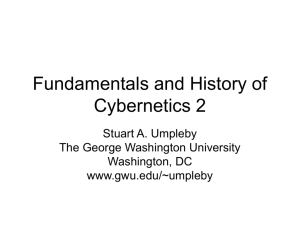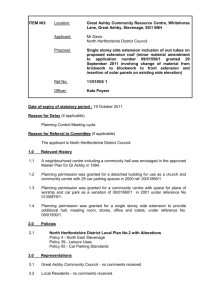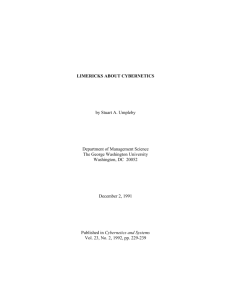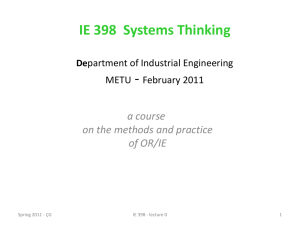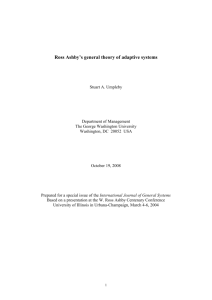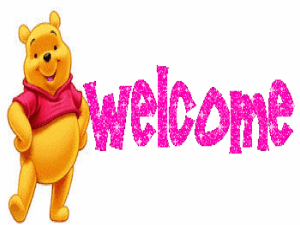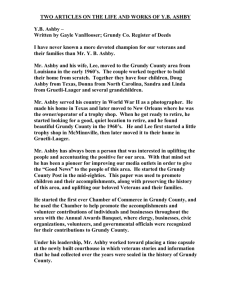Methods for making social organizations adaptive.
advertisement
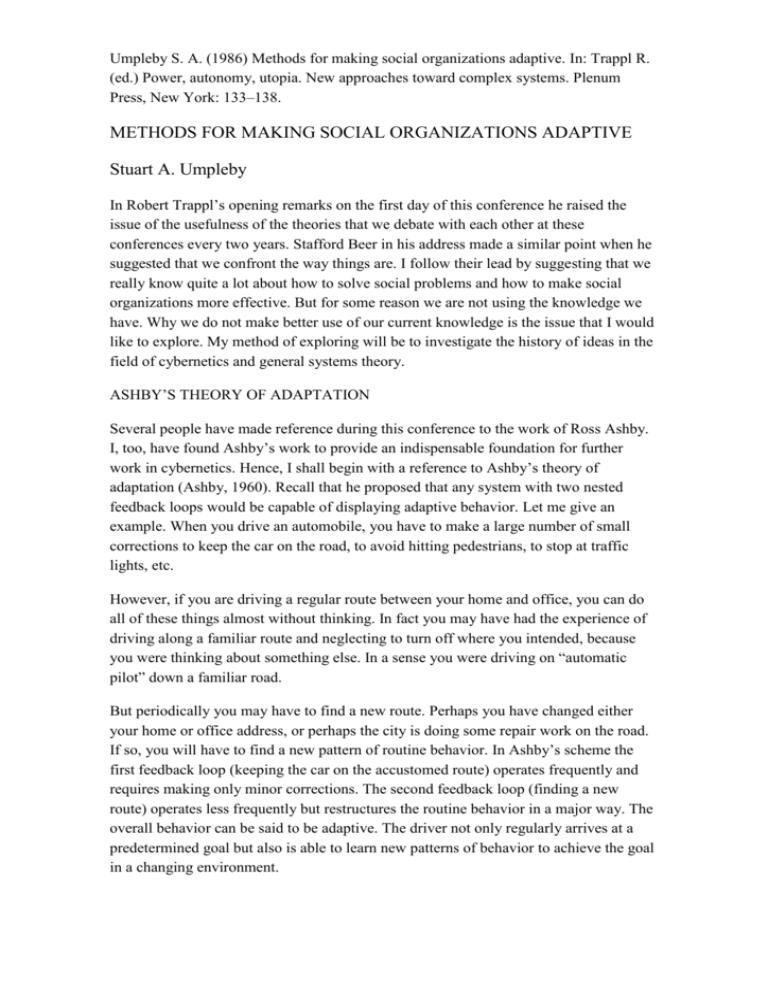
Umpleby S. A. (1986) Methods for making social organizations adaptive. In: Trappl R. (ed.) Power, autonomy, utopia. New approaches toward complex systems. Plenum Press, New York: 133–138. METHODS FOR MAKING SOCIAL ORGANIZATIONS ADAPTIVE Stuart A. Umpleby In Robert Trappl’s opening remarks on the first day of this conference he raised the issue of the usefulness of the theories that we debate with each other at these conferences every two years. Stafford Beer in his address made a similar point when he suggested that we confront the way things are. I follow their lead by suggesting that we really know quite a lot about how to solve social problems and how to make social organizations more effective. But for some reason we are not using the knowledge we have. Why we do not make better use of our current knowledge is the issue that I would like to explore. My method of exploring will be to investigate the history of ideas in the field of cybernetics and general systems theory. ASHBY’S THEORY OF ADAPTATION Several people have made reference during this conference to the work of Ross Ashby. I, too, have found Ashby’s work to provide an indispensable foundation for further work in cybernetics. Hence, I shall begin with a reference to Ashby’s theory of adaptation (Ashby, 1960). Recall that he proposed that any system with two nested feedback loops would be capable of displaying adaptive behavior. Let me give an example. When you drive an automobile, you have to make a large number of small corrections to keep the car on the road, to avoid hitting pedestrians, to stop at traffic lights, etc. However, if you are driving a regular route between your home and office, you can do all of these things almost without thinking. In fact you may have had the experience of driving along a familiar route and neglecting to turn off where you intended, because you were thinking about something else. In a sense you were driving on “automatic pilot” down a familiar road. But periodically you may have to find a new route. Perhaps you have changed either your home or office address, or perhaps the city is doing some repair work on the road. If so, you will have to find a new pattern of routine behavior. In Ashby’s scheme the first feedback loop (keeping the car on the accustomed route) operates frequently and requires making only minor corrections. The second feedback loop (finding a new route) operates less frequently but restructures the routine behavior in a major way. The overall behavior can be said to be adaptive. The driver not only regularly arrives at a predetermined goal but also is able to learn new patterns of behavior to achieve the goal in a changing environment. Large social organizations such as corporations and government agencies also display adaptive behavior. They take many small corrective actions each day but only occasionally make a major change, such as [134] introducing a new product or buying or selling a subsidiary firm. The question that I would like to ask is: Have we given sufficient attention to BOTH feedback loops? It seems to me that most of the work that has been done in cybernetics and systems theory has tended to focus on small corrections in organizations. I think that we have done a very good job of advancing the technology for managing day-to-day operations. But our efforts in this area seem to be yielding diminishing returns. The gains have not been as great in recent years as they were in the years immediately after World War II. The kinds of difficulties that American mana9ers are facing today tend to be less technological than cultural. That is, there is at least as much attention being focused now on how to get people to use existing technology as there is on developing additional technology. THE INTERACTION BETWEEN IDEAS AND SOCIETY When one attempts to make a major change in an organization, such as the adoption of a new technology, one encounters a great deal of resistance. People have established customs and patterns of behavior that are familiar and are not given up easily. The kinds of approaches that are usually found within the field of operations research or the mathematical decision sciences do not address the question of how one achieves widespread support for a major transformation of a social organization. Although there has been some very nice work on organizational structure and the ideal design of a viable system, a question that remains is how one achieves widespread support for the change from the existing structure to the preferred structure. One of the truths we tend to forget is, “What we think determines how we act, and we can change the way we think. “ Let me give several examples to illustrate the point. The examples come from science, everyday life, international relations, and management consulting. In the case of science there is a fundamental difference between the natural sciences and the social sciences. When a major change in theory occurs in the physical sciences, we assume that only the theory changes. The behavior of objects does not change. When physicists changed their principal theory from classical mechanics to modern quantum mechanics, the behavior of atoms did not change. But in social science, the situation is quite different. In fact, one of the reasons we formulate theories of social systems is that we want our social systems to operate differently. In the case of everyday life we also understand the interaction between ideas and circumstances. For example it is possible to have a small income and yet be content as long as one’s wants lie within one’s resources. However, it is also possible to have a large income and not be content, that is, if one’s reach exceeds one’s grasp. In the case of international diplomacy there are a number of successful applications of theories which assume an interaction between ideas and behavior. One example was the effort by President John F. Kennedy during the period following the Cuban missile crisis to obtain a Nuclear Test Ban Treaty. Between October 1962 and the summer of 1963, a period of about nine months, Kennedy, obviously with the cooperation of Khrushchev, was able to achieve a major reversal in the climate of Soviet–American relations by applying a theory of graduated and reciprocated initiatives in tension reduction. (Etzioni, 1967) In the case of management consulting, we know a great deal about how to improve our work environments. There are some organizations that are dynamic and innovative. There are other organizations where people [135] complain a lot. When people are unhappy, they are not as productive. Consequently methods have been developed for transforming a less productive organization into a more productive organization. The point is that we do have the means to transform our social systems. Of course individuals and societies must change at their own pace. Nevertheless, methods do exist for making major changes in a fairly short period of time. Perhaps I should give one or two examples of the methods that I have in mind. I shall then describe the assumptions that these methods are based upon. I think you will see that a theoretical foundation for these methods would entail a major departure from the theories and epistemologies that underlie most of the papers we present at conferences of this sort. DESIGNING DISCUSSIONS TO RESTRUCTURE ORGANIZATIONS If we accept the idea that the way to change behavior is to change the way that people think and the idea that organizations are composed of many independent human beings, then the task is to lead the people in an organization through a discussion so that they jointly arrive at a new, more productive pattern of behavior. Numerous methods have been divised to lead such a group discussion. I shall briefly describe just two of them. The first method for conducting a group discussion or a planning meeting within an organization is called LENS, which stands for Leadership Effectiveness and New Strategies. (Umpleby, 1983) The method has been developed by the Institute of Cultural Affairs, a community development organization based in Chicago. The method involves leading a structured discussion. An activity of this kind is somewhat analogous to conducting an orchestra. First one writes the score, and then one leads the playing of the score. In the case of LENS the group proceeds through a discussion of their ideas about five things. (1) Their vision of the future. What they want for themselves, their families, and their community or organization. (2) The contradictions or obstacles to achieving the vision. If people agree upon a common vision, why do they not have it? What are the factors that are impeding progress? (3) Programs to remove the obstacles to achieving the vision. (4) Tactics for implementing the programs. (5) Who will do what, when, where, and how in order to carry out the tactics. The LENS method is usually performed during a five day conference. However, shorter versions can be done in less than one day. Regardless of the length of time devoted to the meeting, some time is spent together as a single group and some time is spent in smaller groups, so that everyone has an opportunity to speak. Expanding participation both generates additional ideas and builds commitment to the plans that are eventually formulated. The method developed by Russell Ackoff and his colleagues for dealing with corporate clients is similar. (Ackoff, 1981) Their method also involves a series of discussions. However, rather than starting with a vision of the future and then looking at the obstacles to achieving it, [136] Ackoff assumes that the vision in most organizations is to continue doing what they are doing. He feels that in order to convince corporate managers that change is needed, it is necessary to show them that their current policies will eventually lead to collapse and ruin. Hence in Ackoff’s method the first step is to project current behavior in order to identify the mode of future collapse. Once the future failure hidden within current practices is identified, it is then possible to create an idealized design that will avoid that future problem or set of problems. Subsequent steps involve ends planning and means planning. Ackoff uses technical analysis more than the Institute of Cultural Affairs which focuses on training and motivation. Using our musical analogy again, the difference can be thought of as the difference between two composers. Both are designing a pattern of behavior for a group of people to carry out. In each case the result of the planning activity is a new pattern of organizational behavior. There is an emotional component to this kind of activity regardless of who the composer is. Hence, a successful composition must also deal with this aspect of the group’s interactions. To do this, one must be aware of, and at least in part redesign, the myths that exist within the organization. For example, the Institute of Cultural Affairs writes songs about the organization that summon up pride in the past, hope for the future, good will toward fellow workers, and a determination to overcome obst.acles. The Institute also uses symbols that remind people of the feelings that they have when they are working successfully together. HOW NEWER METHODS DIFFER FROM OLDER METHODS Now let us look at how these methods, which have been successfully used in communities, corporations, and government agencies, are different from the usual mathematical applications of cybernetics and systems theory. The methods I have described have not had their origins in the purely academic world. They are the result of practice. They have been developed by people who were trying to get things done in organizations. Here is a list of some of the characteristics or underlying assumptions of the LENS method. The LENS method differs more sharply from classical decision science than does the work of Ackoff and his colleagues. (1) The problems are virtually never clearly defined. There is a set of interrelated problems. (2) The focus is on action at least as much as analysis, that is, in moving in a positive direction, even if one does not have a complete analysis to begin with. The reason lies in the need to restore or maintain hope that positive change can take place. (3) There is more attention paid to getting people to work cooperatively together than to devising an optimal solution. Hence the focus is on psychological constraints more than physical constraints. Rather than optimizing within physical constraints, the task is to remove psychological constraints. (4) Regarding data it is assumed that the people taking part in the meetings have sufficient data in order to act. Usually one tries to get people outside the organization to take part in order to bring fresh perspectives and additional skills. [137] (5) The procedure for implementing the plan is part of the plan that is developed. One does not solve a problem and then hand the solution to a decision-maker. Rather, the people who will have to implement the plan are the people who formulate it. (6) The emphasis is not on using an analytical technique but rather on improving communication among the people involved. The central concerns are motivation, organization, and cooperation and how to achieve them. Now the question is, since these methods are rather widely known, why do we not pay more attention to this kind of work? I think that an important reason lies in our epistemology. In order to understand theoretically what is happening when these methods operate, we have needed new concepts that we did not have before. Some of the necessary concepts are presented in the papers in this volume. First of all, we need to think of individuals as autonomous elements. We need to think of a social system as a collection of autonomous elements where each one of those elements creates its own vision of the world. People have their own views of their personal goals, the goals of the organization, and how they want to interact with the organization. Those ideas and aspirations need to be included in the plans that are developed. Also, we need to think of knowledge not as something in the mind of an expert, but rather as something that is shared by a group of people. Contrary to this notion of a social system as a collection of autonomous individuals constructing their own realities, decision scientists have tended to think of social systems as a set of interacting variables. We have asked questions such as, “If variable A increases, what will happen to variable B?” Once a model was constructed, our concept of implementation was to make a recommendation to a decision-maker who would then issue the necessary commands. This conception is more compatible with Ashby’s first feedback loop (small day-to-day corrections) than with Ashby’s second feedback loop (a major change in the pattern of behavior) . The new methods have been designed to deal with major structural change. A more appropriate question from the perspective of the new methods and the new epistemology is to ask, “How can we design a discussion so that people come to agreement on topics that will improve the functioning of the organization?” Our older mathematical methods constitute a powerful technology, but they are a long way in their basic assumptions from the idea of a social system as a set of interacting, autonomous human beings. The lack of an epistemology compatible with the newer methods is probably an important part of the explanation for why the newer methods are not more widely used. When we use the methods that I have described, we shift from being a technical analyst to being a person who composes and then conducts a discussion among a group of people. There seem to be two routes whereby one can come to an understanding of the ideas presented in this symposium. One route is to do client-based work. The other route is through epistemology. The two areas of inquiry are mutually supportive. With the work that has been done in the area of second order cybernetics, it is now possible to have a more thorough theoretical understanding of the kinds of group process methods that have been shown to be effective. [138] REFERENCES Ackoff, R. , 1981, “Creating the Corporate Future”, J. Wiley, N. Y. , London, and Sidney. Ashby, W. R. , 1960, “Design for a Brain”, Second Edition, Chapman and Hall, London. Etzioni, A. , 1967, The Kennedy Experiment, The Western Political Quarterly Vol. XX, No. 2, Part 1. Umpleby, S. A. , 1983, A Group Process Approach to Organizational Change, in: “Adequate Modeling of Systems”, Horst Wedde, ed. , Springer Verlag, Heidelberg and Berlin.
